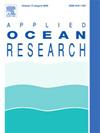Experimental study on the drag reduction of underwater vehicles by drag-reducing agents injection
IF 4.3
2区 工程技术
Q1 ENGINEERING, OCEAN
引用次数: 0
Abstract
Underwater vehicles consume much energy to overcome flow resistance; therefore, reducing drag is essential to enhancing its performance. This paper proposes a drag reduction method for underwater vehicles by injecting drag-reducing agents into the turbulent boundary layer of the underwater vehicles and experimentally evaluates its performance based on the scaled suboff model. To this end, the unique injection structure and location are carefully designed to ensure the adherence of the drag-reducing solution on the wall. The polyethyleneoxide (PEO) and ceytltrimethyl ammonium chloride (CTAC) solutions are chosen as the drag-reducing agents. The effects of concentrations, flow rates, and mainstream Reynolds numbers (Re) on the drag reduction performance are investigated by measuring the total drag resistance of the scaled suboff model under different conditions. The results demonstrate that this heterogeneous drag-reducing solution injection strategy performs well in terms of drag reduction for the suboff model. The specially designed injection structure can uniformly distribute the drag-reducing solution to the near-wall region of the suboff model. Under certain conditions, both PEO and CTAC solutions can significantly reduce the total drag resistance and have an optimal concentration at different Re. At their optimal concentrations, the drag reduction of the total resistance can achieve about 59.38% and 48.31% for PEO and CTAC solutions, respectively, at Re = 2.7 × 104. However, with the current design, the drag reduction decreases with the increase of Re due to the difficulty of the drag-reducing agent wrapping around the suboff model effectively. Further work is still necessary to improve the design and the location of the injection structure so that it can adapt to high-Re cases.
通过注入减阻剂减少水下航行器阻力的实验研究
水下航行器需要消耗大量能量来克服流动阻力,因此减少阻力对提高其性能至关重要。本文提出了一种通过向水下航行器的湍流边界层注入减阻剂来减少水下航行器阻力的方法,并基于缩放子模型对其性能进行了实验评估。为此,我们精心设计了独特的注入结构和位置,以确保减阻溶液附着在壁面上。我们选择了聚环氧乙烷(PEO)和十六烷基三甲基氯化铵(CTAC)溶液作为减阻剂。通过测量按比例缩小的 suboff 模型在不同条件下的总阻力,研究了浓度、流速和主流雷诺数 (Re) 对减阻性能的影响。结果表明,这种异质减阻溶液注入策略对 suboff 模型的减阻效果良好。特殊设计的注入结构可以将减阻溶液均匀地分布到 suboff 模型的近壁区域。在一定条件下,PEO 和 CTAC 溶液都能显著降低总阻力,并在不同的 Re 值下具有最佳浓度。在 Re = 2.7 × 104 时,PEO 和 CTAC 溶液的最佳浓度分别可使总阻力降低约 59.38% 和 48.31%。然而,在目前的设计中,由于减阻剂难以有效地包裹子模型,因此减阻效果随着 Re 的增加而降低。还需要进一步改进喷射结构的设计和位置,使其能够适应高 Re 的情况。
本文章由计算机程序翻译,如有差异,请以英文原文为准。
求助全文
约1分钟内获得全文
求助全文
来源期刊

Applied Ocean Research
地学-工程:大洋
CiteScore
8.70
自引率
7.00%
发文量
316
审稿时长
59 days
期刊介绍:
The aim of Applied Ocean Research is to encourage the submission of papers that advance the state of knowledge in a range of topics relevant to ocean engineering.
 求助内容:
求助内容: 应助结果提醒方式:
应助结果提醒方式:


